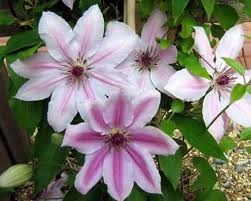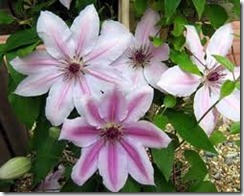Nelly Moser clematis is a variety of the flowering vine that is bicolored. Nelly Mosers are large-flowering clematis, a species related to the buttercup, even though the flower colors and sizes vary. This type of clematis can grow as tall as 10 feet, according to the Clemson University Extension, and blooms in the late spring to early summer and again in the fall. Take care of your Nelly Moser clematis to encourage the large flowers to bloom and stay healthy. Nelly Moser clematis grows best in USDA hardiness zones 4 to 8, or temperatures ranging from -30 degrees to 20 degrees Fahrenheit.
Difficulty: Moderate
Instructions
Things You’ll Need:
- Shade
- Trellis
- Pruning shears
- Watering system
- Fertilizer
- Mulch
-
Place your Nelly Moser clematis in the shade, as this variety of the species can’t take full sun without fading. If your vines are already well-established in a sunny spot, create shade through further landscaping with shrubs and trees, or even a well-placed garden umbrella, rather than transplanting the clematis.
-
Provide a trellis for your vine to creep onto for support. Young clematis vines of any kind, including Nelly Moser, can be thin and weak until they have matured. Use supports like poles if you don’t have space for a latticework wall or trellis in your garden.
-
Prune your Nelly Mosers in the winter — Ohio State University suggests February or March as ideal pruning times — to remove dead buds and insufficient or weak vines, and to promote spring blooming. Prune back as far as the topmost green buds to control overgrowth; in some cases you’ll be cutting just a few inches, but you could also remove significant lengths of vine if your clematis is especially hardy.
-
Water Nelly Moser clematis frequently enough so that the plant gets about an inch of water each week, recommends Reiman Gardens at Iowa State University. Ensure that your soil drains well to avoid root rot. During nonblooming periods in the spring, your clematis can also benefit from a plant food or fertilizer mixed into the soil bed. Ohio State University suggests using 1/2 lb. of fertilizer for 50 square feet of soil; reduce this ration to accommodate your garden’s size.
-
Mulch your vines in the late spring and again in autumn to protect the roots against temperatures of either extreme.


Deprecated: strpos(): Passing null to parameter #1 ($haystack) of type string is deprecated in /home/agriviek8Qv/agriviet.net/public_html/wp-includes/comment-template.php on line 2522